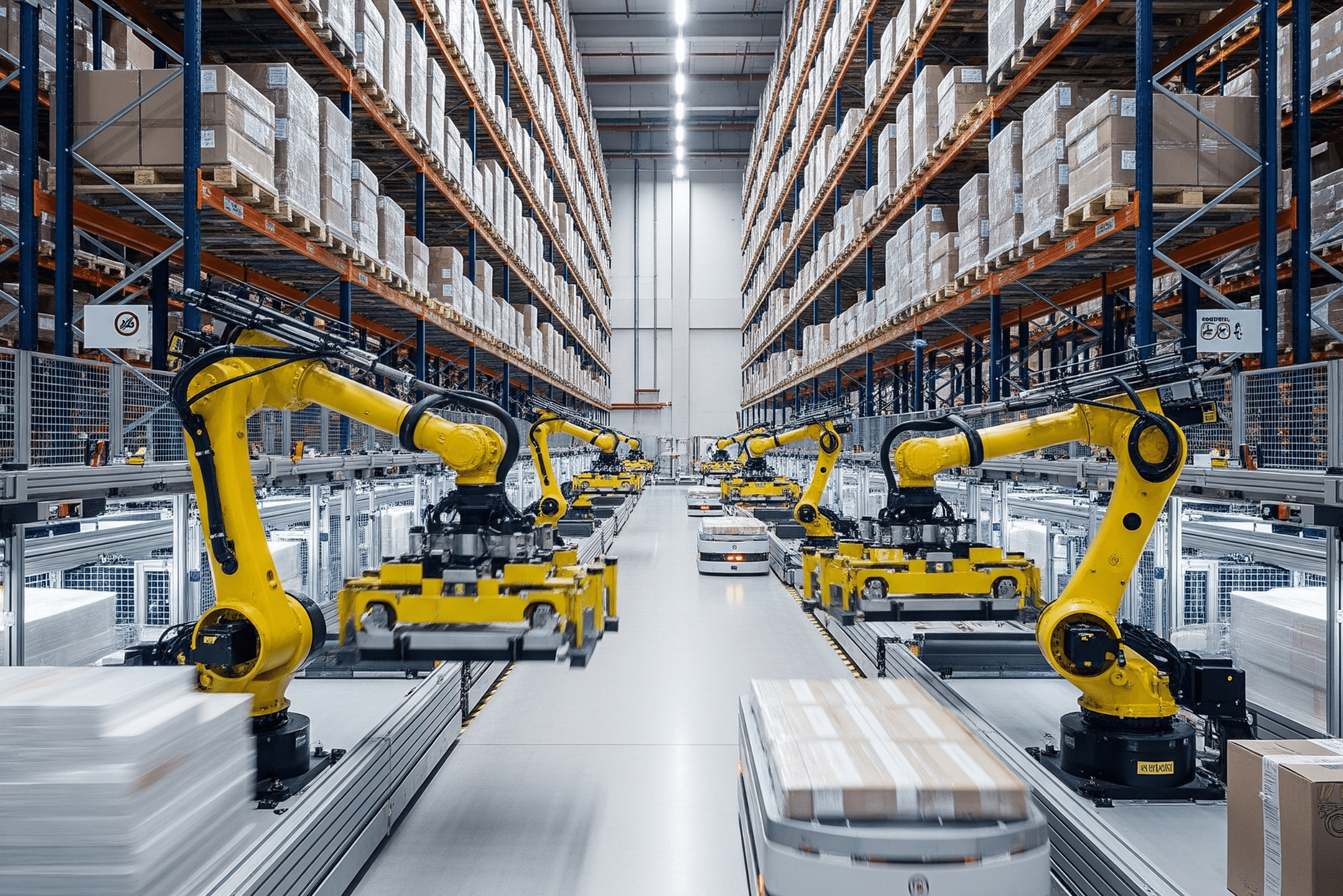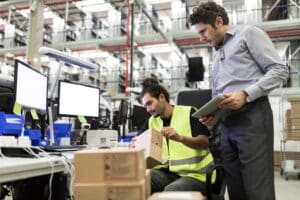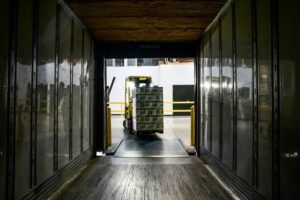Warehouse automation: our guide to understand everything
Logistics
4.0 solutions
Supply Chain
July 18, 2025

Over time, warehouse automation has become a strategic necessity.
Faced in particular with the explosion of e-commerce, pressure on delivery times and the shortage of labor, companies must rethink their logistics organization in depth. And at the heart of this transformation: automation.
But what does this really imply? What technologies are to be preferred? How can a WMS solution help you? How does it fit into this mutation?
The warehouse of the future is already there.
Why automate your warehouse?
Reduction of errors and costs
Human errors in preparing orders are expensive. Very expensive.
According to Blogistics, a picking error results in an average cost of around € 20 per order , in particular due to reverse logistics (feedback flow), disputes and re-payment. Multiply this by hundreds or thousands of monthly expeditions, and you get a financial abyss.
Automating is above all reliable.
Thanks to robotization, picking errors drop drastically. Repetitive tasks are thus supported by automated systems, releasing operators for higher added value missions.
Improved productivity
It is not a secret for anyone, a robot does not tire.
Goods to Man solutions, such as those offered by Exotec or Autostore, bring the bins directly to the operator.
Result : less trips, less time lost, and a rate of processing of significantly higher orders.
Optimization of storage space
In a warehouse 4.0 , each square meter counts and costs.
Automated systems allow storage densification up to 4 times that of a traditional warehouse. The bins are stacked to the nearest millimeter, without leaving unnecessary space.
Automation in urban areas, where the square meter is expensive, is a real advantage.
Resilience in front of the vagaries
Sanitary crises, seasonal activity peaks, unforeseen absences ...
Automation makes warehouses more resistant in order to deal with the various challenges. Also, thanks to integrated technological solutions such as WMS, and autonomous robots, you limit operational ruptures.
Activable checklist: should you automate your warehouse?
- Analyze your current errors in preparation
- Evaluate the costs of non-quality linked to logistics
- Identify the repetitive chronophagous tasks
- Study your stock rotation rate
- Measure your current performance (otit, productivity/h)
- Calculate the potential king of automation
Key automation technologies
1. Goods to Man
The principle : it is no longer the operator who will seek the product, but the product that comes to him.
This technology has the advantage of drastically reducing travel and increasing the preparation rate. It can be based on bins transported via conveyors, robots or automated elevators directly to a preparation station for example. Thus, the operator remains at his post and has the possibility of preparing several orders simultaneously.
Actors like Exotec with its Skypod or Autostore robots with its bins stored in a cubic structure are very good examples which illustrate these systems very well.
2. Automated storage systems
Kardex, SSI Schäfer…
These solutions make it possible to store thousands of references on a reduced surface, while maintaining fluid access. For example, they include transstockers, miniloads and automated carousels.
The use of these storage systems is particularly relevant in high -rotation warehouses or requiring precise stock control.
Tip : Thanks to interfacing with WMS software, these solutions can send the right product in real time, at the right time, to the right station.
3. Autonomous mobile robotics (AMR)
Unlike AGV (automatic guidance vehicles), AMRs are able to move freely in the warehouse without fixed guidance and make decisions in real time.
Equipped with sensors providing them with dynamic cartography, they avoid obstacles and redirect their journey if necessary. These mobile robots are ideal in internal transport, picking or stocking missions. It is therefore not uncommon to find them carrying bins, packages or pallets between storage, preparation and shipping areas.
Their advantages : they improve security, reduce internal deadlines and allege the physical load of operators.
4. Artificial vision and AI
Thanks to on -board cameras and artificial intelligence, certain systems can recognize, count, check or automatically sort items.
The Signature One company, for example, has developed connected work tables and 4.0 trolleys to provide precision. Also, the reported information allows operators to be more efficient in their daily work. These technologies are therefore completely integrated into the control, sorting or palletizing positions.
Associated with logistical traceability software, artificial intelligence solutions strengthen the rigor of operations and reduce human errors.
5. Cobotics: Man-Machine collaboration
The role of cobots (collaborative robots) is to work hand in hand with operators.
In everyday life, they assist humans in order to release them from repetitive, complex, even dangerous tasks. In no case they replace the operators. On the contrary, they allow them to focus on value added tasks such as decision -making and data analysis for example.
Thus, in warehouses, cobots are very efficient in the preparation of orders by avoiding operators arranged in Picking to leave their work zone.
Activable checklist: Choosing the right technology
- Analyze your flow typology (volume, rotation, diversity of references)
- List the most time -consuming operations of your warehouse
- Identify the tension zones (deadlines, errors, ruptures)
- Determine your goals (space gain, speed, reliability)
- Check compatibility with your current infrastructure and warehouse management software
- Prepare a technical and financial feasibility study
The cornerstone of automation: WMS software
Intelligence behind the machine
An automated warehouse does not work without brain.
Warehouse Management System ) software
It is he who orchestrates the flows, coordinates the equipment, and pilots all the logistics processes. It interfaces with robotic solutions, ERPs, transport software such as MSDs and business tools.
Ultra optimized storage management
Thanks to a WMS solution, each mission and location are optimized according to dynamic criteria: stock rotation, volume, picking frequency, storage constraints, choice of the best route in the warehouse ...
It anticipates needs, adapts preparation strategies, manages priorities. All in real time .
Complete and compliant traceability
One of the advantages of a WMS is traceability. Thanks to him, each article, each movement, each batch, each order is followed, from the supplier to the end customer.
A legal obligation in many sectors ( food , health, cosmetics), but also a lever for customer reinsurance which keeps control in the management of its warehouse.
Connection to a digital ecosystem
Warehouse management software never works alone.
It intervenes in many solutions such as: ERP, MSD, business solutions, marketplace, web platforms ... It becomes a nerve center allowing you to control your whole supply chain.
Activable checklist: set up a WMS solution compatible with automation
- Define your specific business needs
- Choose scalable and modular WMS software
- Check compatibility with your current and envisaged equipment
- Provide a change support for teams
- Integrate reporting and data analysis tools
Automation brakes and how to overcome them
Automating a warehouse is not just about investing in robots and Goods to Man solutions. The path to a warehouse 4.0 can be strewn with pitfalls if it is not properly marked. For this, you have no choice but to identify and remove these obstacles to guarantee a return on investment.
1. The initial investment cost
It is the most often quoted brake.
It is true, automation technologies represent a significant investment. But we must go beyond this short-term vision. The king of a WMS solution coupled with well thought out automation is often measured in less than 3 years.
Key of success: prioritize areas with high gains potential and automate steps stages.
2. Resistance to change
Change of habits is one of the main brakes. The teams may fear not mastering new technologies, or even, in some cases, to lose their jobs.
Success keys: involve employees from the implementation phase. Propose concrete training. Value the new roles created by automation (supervision, maintenance, data, etc.).
3. Integration with existing systems
Automated warehouse management software must be interfaced with your ERP, your business tools, your physical equipment ...
Success keys: Choose a modular, scalable WMS solution with several APIS. Provide an integration phase managed by IT experts.
4. Lack of reliable data
Automation is essentially based on data: location, picking frequency, volumes, weight, rotation ...
Success keys: Clean and structure existing data upstream. Set up automatic collection tools via logistical traceability.
Activable checklist: Overcoming automation challenges
- Make a digital maturity audit of your warehouse
- Identify internal brakes (humans, technical, financial)
- Involve operators in the process
- Secure your budget and present the expected king
- Prepare your logistics data upstream of the project
- Choose partners capable of supporting you over time
Far from being a theoretical concept, the warehouse 4.0 is a tangible, measurable, profitable reality.
The automation of warehouses, combined with a high -performance WMS solution, constitutes a major lever to gain competitiveness, reliability and responsiveness.
But this transformation is not done on its own and requires method, vision, and good tools.
Ready to take action?
Make an audit of your current flows. Ask your teams about their real needs. Determine your strategic priorities.
And above all surround yourself with technological partners capable of making your warehouse a real logistics performance center.
The future does not expect. It is built.
Do you want to automate your warehouse? Discover our warehouse management software, WMS Ego , and its possibilities.
Contact us to share your needs with us. After a first exchange, we will come back to you with a demo of our WMS adapted to your environment and your context.
Your warehouse of the future begins now.
Most read articles
WMS software
Logistics
Supply Chain
March 25, 2025
Kpilote: ETL that connects your CMS to WMS Ego
E-commerce logistics connector, Kpilote facilitates data exchange between e-commerce platforms and business software like WMS. Associated with the WMS Ego solution, this ETL guarantees time saving, a reduction in errors and a better customer experience.
WMS software
Logistics
Supply Chain
June 10, 2024
Warehouse management: why use a WMS?
The use of WMS software is today essential to optimize and manage physical flows and stocks in a logistics warehouse. Each warehouse WMS software integration project is unique and requires in-depth reflection as well as the publication of specifications. Your logistics solution must allow you to have an overall view of your activity and its areas for improvement.
WMS software
Logistics
Supply Chain
October 4, 2024
What is a Warehouse Management System (WMS)?
In today's complex world of logistics, a WMS is key to optimizing warehouse operations, improving efficiency and reducing costs. With its advanced features, it helps meet logistics requirements by offering an efficient solution for managing the movement and storage of products within warehouses.

















